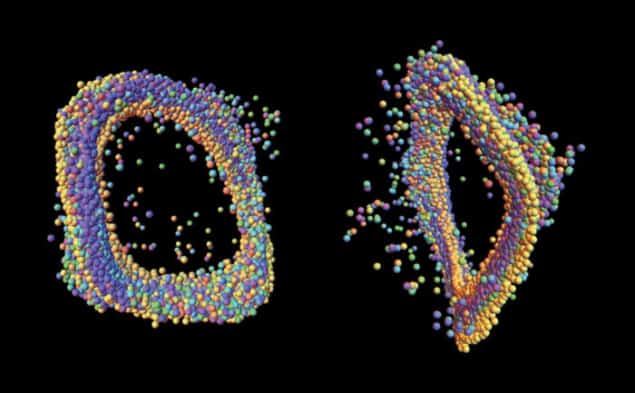
The first stars known to pulsate in a fractal manner have been discovered by physicists in the US and Germany. According to the researchers, the variable stars may be the first “strange non-chaotic attractors” seen outside the laboratory. The objects were found in data from the Kepler space telescope by looking for stars with two characteristic pulsation frequencies that have a “golden ratio” of approximately 1.62. The discovery could shed light on the physics that drives variable stars and also help astronomers come up with better classification systems for these objects.
A variable star dims and brightens as its size and sometimes its shape oscillates at one or more frequencies. Since it was launched in 2009, NASA’s Kepler mission has been a boon to astronomers studying variable stars because the telescope has been monitoring the brightness of more than 100,000 stars in its search for distant planets. However, John Learned of the University of Hawaii and Michael Hippke of the Institute for Data Analysis in Neukirchen-Vluyn in Germany noticed the first strange non-chaotic “golden star” when searching the Kepler data for evidence that advanced extraterrestrial civilizations modulate variable stars to communicate between galaxies.
Geometry of life and art
This star – called KIC 5520878 – is a type of periodic variable star known as an “RRc Lyrae” variable. It pulsates at a large number of frequencies that are all related to two frequencies – f1 and f2 – that have a golden ratio. The golden ratio or “golden mean” is an irrational number that has significance in geometry, biology and art. Its presence in a dynamical system can mean that the system behaves as a “strange non-chaotic attractor”. In this case, “strange” means that the system can be characterized as fractal, and “non-chaotic” means that the dynamics falls in the middle ground between order and chaos.
To study the dynamics of the star, Learned and Hippke joined forces with physicists at the University of Hawaii and the College of Wooster, including John Lindner. To verify that the star is indeed a strange non-chaotic attractor, the team did a “spectral scaling” analysis. First, the researchers did a Fourier transform of a time sequence of the brightness of the star that was acquired by Kepler over a four-year period, creating a power spectrum with peaks at a large number of frequencies. Then, they counted the number of peaks above a threshold value, repeating the process over a wide range of threshold values. Finally, they plotted the number of peaks above the threshold as a function of the threshold.
Norwegian link
They found that the number of peaks was pretty well constant until the threshold reached an inflection point (a point on a curve at which the sign of the curvature changes). When this occurred, the number dropped rapidly and obeyed a power law. According to the team, this behaviour is indicative of strange non-chaotic dynamics. Interestingly, Lindner points out that a similar analysis of the variability of the coastline of Norway yields the same power-law exponent of –1.5. The team also did an “attractor reconstruction”, whereby the time evolution of the brightness of the star is plotted. The researchers found the attractor to be a “warped torus” (see figure), which is indicative of a non-chaotic system defined by two frequencies and involving non-linear dynamics.
While several strange non-chaotic attractors have been created in the lab based on magnetic, electrochemical, electronic and atomic systems, Lindner and colleagues believe that KIC 5520878 is the first to be found in nature. The physicists then applied their analysis to three other RRc Lyrae variable stars that also have two frequencies with ratios close to the golden mean. They found exactly the same power-law relationship. Finally, they looked at two variable stars that have frequency ratios that are not the golden ratio – but rather are simple fractions – and found that these did not obey power laws.
Quasiperiodic instabilities
As well as offering astronomers a new way to classify variable stars, the strange non-chaotic nature of some stars could help scientists gain a better understanding of the physics underlying stellar pulsations. In a stable star the inward gravitational pressure is balanced by the outward pressure of light. In some regions of a star, however, an increase in temperature can make the star more opaque, thereby reducing the amount of light that can escape. This can cause a build-up of pressure that is relieved by the star expanding. It is this sort of instability that could be responsible for driving the pulsations in a non-linear manner involving two frequencies.
The team is now studying other variable stars that could be strange non-chaotic attractors, and Lindner points out that many RR Lyrae and Cepheids appear to have frequency ratios near the golden mean. “Currently, we suspect that the RRc Lyrae stars, a previously recognized subclass of about 9% of RR Lyraes, may all be golden and strange non-chaotic,” he says. He also says that an important open question is whether all golden-ratio stars exhibit strange non-chaotic behaviour.
The research is described in Physical Review Letters.



